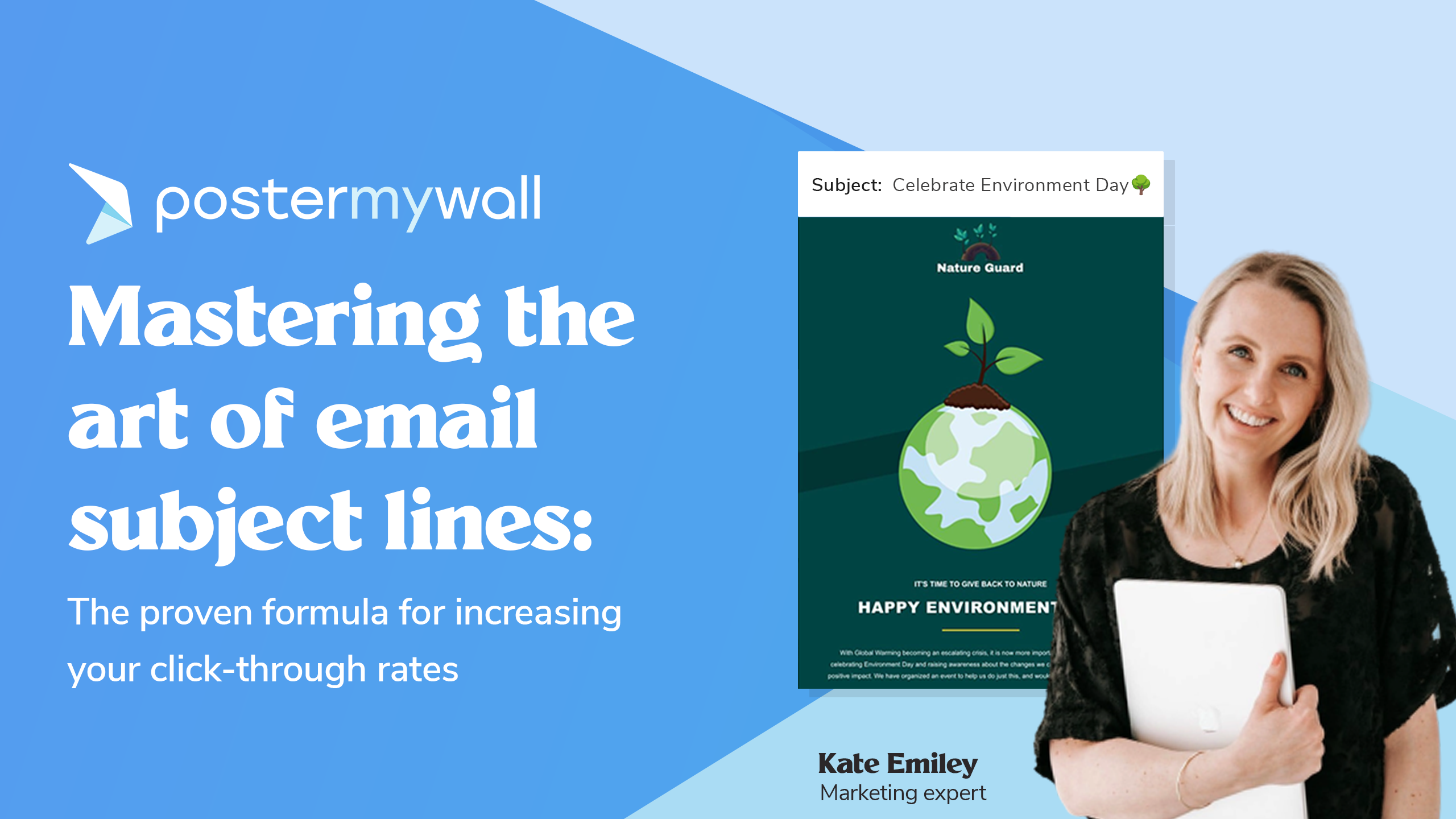Do you leverage the power of email marketing for your brand or business? If you’re not, you should.
Email marketing is one of the most effective channels for communicating with an audience online. There’s a reason over 300 billion emails are sent every day! But if you’re just getting started, stepping into email marketing can seem daunting.
We consulted with Matt Snyder, an agency email marketer and content strategist, to give us a play-by-play guide for those who are new to email marketing.
In this article, he will discuss:
- Why Email Marketing?
- Defining Your Email Purpose
- Determining Your Email Strategy
- Getting Started: What You Need to Begin
- Acquiring Email Subscribers
- Writing Your Welcome Series
- Writing Your First Email Campaign
- Growing with Email Marketing
Why Email Marketing?
If you’ve been around the block on the internet for some time now, you may have heard the saying, “Email marketing is dead.”
The saying emerged over a decade ago, and clearly, email marketing isn’t going anywhere. So why invest your time and resources into the channel?
- If you run an online store, it’s an easy way to connect one-on-one with your customers, build customer loyalty, and even sell more products.
- If you run a nonprofit, it’s an effective way to connect with your supporters, build relationships, and raise more donations.
- If you’re a SaaS company, it’s an essential medium for connecting with your users and creating a better user experience.
- If you’re a freelancer, it’s a great way to connect with clients, build trust, and possibly land more projects.
The list could go on as there are numerous ways to leverage email marketing for your business. So how do you begin?
Define Your Purpose
The biggest mistake email marketers make at the beginning is they never define their purpose for marketing using email in the first place.
Before you think you’re immune, multi-million dollar eCommerce companies can make this mistake just as often (though more abrasively) as small fledgling nonprofits!
Defining your purpose upfront helps you develop a targeted and effective email strategy. It becomes your compass to guide your segmentation strategies, email campaigns, automations, sign-up incentives, and more.
If you need help getting your creativity flowing to develop your own “email purpose statement,” consider using this template:
[COMPANY NAME] will use email marketing to send email [CAMPAIGNS AND/OR AUTOMATIONS] to [AUDIENCE] in an effort to [GOAL].
Here’s an example using a fake company name:
Fido’s Dog Food will use email marketing to send emails to prospective and existing customers in an effort to cultivate brand trust, build brand loyalty, and increase first-time and recurring online purchases.
Determine Your Email Strategy
Once you’ve defined your purpose, it’s time to nail down your email marketing strategy. Your strategy is your plan on how you will carry out your email purpose.
There are two main ways to do this: email campaigns and email automations (also called email flows).
Email Campaign Strategy
Email campaigns are what most beginner email marketers are most familiar with. These are one-off emails sent out to a targeted segment or group of subscribers.
Common email campaigns include:
- Newsletters
- Blog Updates
- Discounts or sale announcements
- Product highlights
- Customer reviews
- and more
For more ideas read: “12 Different Types of Marketing Emails You Could Be Sending” (via HubSpot)
The types of campaigns you send will be based on how you best want to leverage email marketing to accomplish your purpose.
For the Fido’s Dog Food example above, I might use these types of campaigns:
- Discount/Sale announcements
- Product highlights + value props
- Bestsellers features
- Customer stories
- Behind the brand emails
- Giveaways
Email Automations (or Email Flows)
Email automations are what they sound like – emails are automatically sent out to subscribers based on different behavior triggers.
These types of emails are more complicated to set up, but help you maintain healthy list hygiene and connect with your subscribers on autopilot.
Common email automations include:
- Welcome Series
- Onboarding Emails
- Browse Abandonment
- Abandoned Cart
- Post Purchase
For more ideas read: “Top 10 Email Automation (or Flows) to Setup Right Now” (via Klaviyo)
As with campaigns, the email automations you set up will be based on how you want to leverage email marketing to accomplish your purpose.
For the Fido’s Dog Food example above, I might use these types of automations to start:
- Welcome Series
- Abandoned Cart/Checkout
- Post Purchase
- Replenishment
- Winback
Getting Started: What You Need Before Sending Your Launching Your Email Strategy
There are a couple of things you need to have in place before launching your email strategy: a chosen Email Service Provider (ESP) and a dedicated sending email address.
Both warrant more attention than can be given here, but here are my top recommendations for ESPs as well as a few resources on setting up a sending email address:
Recommended Email Service Providers:
- PosterMyWall – ideal for brands with small budgets that want to hit the ground running with beautifully designed email campaigns. You’ll find tons of email templates within PosterMyWall that will help you create an email that fits your brand without the need to create a snappy email layout.
- Mailchimp – ideal for DTC/eCommerce brands, nonprofits, service providers, churches, and freelancers. Easy for beginners but robust enough for experts.
- Klaviyo – ideal for DTC/eCommerce brands who want to leverage email and SMS to increase revenue.
- ConverKit – ideal for bloggers, service providers, or those who don’t intend to get too aggressive with email marketing.
Resources for Setting Up Sending Email Addresses:
- Setting up Domain Email Authentication (Mailchimp)
- Guide to Email Deliverability (Klaviyo)
- Getting Started with Guided Warming (Klaviyo)
- Guide to Dedicated Sending Infrastructure (Klaviyo)
Acquiring Email Subscribers
Once you’ve established your email marketing purpose and strategy, and set up your ESP, it’s time to begin acquiring subscribers.
There are multiple collection methods, but the most popular method is offering an incentive to sign-up using a landing page or pop-up.
Landing Pages
Many email marketers exclusively design landing pages for acquiring email subscribers. The page targets a certain type of subscriber and uses copy, imagery, and incentive offers to appeal to a specific type of person.
See Example: Sunbasket $90 Off
Pop-Ups
The more popular of the two, pop-ups are an effective way to steal the attention of visitors to your website and acquire potential email subscribers. They also target a certain type of subscriber using compelling language and a specific incentive.
See Example: Top 10 Sign-up Forms from 2021 for Success in 2022 (Klaviyo)
Most email service providers (e.g. Mailchimp, Klaviyo, etc.) include sign-up forms and landing pages as a part of their service, making designing them effortless.
My recommendation is to include a sign-up incentive most appealing to your preferred email subscriber.
For instance, to continue with the Fido’s Dog Food example, I would likely offer potential subscribers 10-15% off for signing up for my email list.
Write Your Email Welcome Series
After you’ve created a way to acquire subscribers and developed an incentive, it’s best to set up a welcome series to deliver your offer and introduce subscribers to your brand.
A welcome series is an email automation (or email flow) triggered when someone joins your email list. Your email service provider should have built-in tools allowing you to create primary flows such as a welcome series.
Most welcome series contain anywhere from 3-5 emails. Here is a simple strategy for a welcome series for our Fido’s Dog Food example:
- Email 1: Deliver the Incentive (15% Off)
- Email 2: Share the Brand Story
- Email 3: Brand Value Props
- Email 4: Highlight Bestsellers
- Email 5: Reminder of 15% Offer
For more ideas read: “Welcome Emails” (via Email Marketing for Normal People)
Write Your First Email Campaign
With all of your basics setup and with people subscribing to your list, it’s time to draft your first email campaign!
What email campaigns you send will be determined by your email strategy (see above). Remember, these include sales emails, customer stories, product highlights, and more.
Best Practices for Sending Email Campaigns:
- Be consistent. If you tell subscribers you’re going to email them 1x each week, then email them at that frequency.
- Follow the Rule of One. Write one message, to one person, with one call to action. Don’t try to cram too much into one email. You’ll confuse your reader.
- Segment your list. Don’t send emails to “all subscribers” every time. Send campaigns to the right audience strategically.
- Plain Text vs. Image-Based. Designed emails are all the rage right now, especially in eCommerce circles. But change it up once in a while and send a plain text email! You’ll stand out in the inbox and help improve your email deliverability.
Resources for Developing Email Campaigns:
- Really Good Emails – great for finding inspiration.
- Milled – see the latest email campaigns from your favorite brands.
- Anatomy of an eCommerce Email – breakdown of key elements in any good campaign
- Improve Email Deliverability and Avoid the Spam Folder (Klaviyo)
- Storytelling and Email Campaigns (Klaviyo)
- 26 Examples of Brilliant Email Marketing Campaigns (HubSpot)
Growing with Email Marketing
If you’re just starting out with email marketing, the previous sections should point you in a sufficient direction to help you get started.
However, as with any marketing channel, you need to establish a rhythm to ensure it’s helping you achieve your goals.
- Measure your progress. Determine the key performance indicators you want to track to be certain email marketing is working for you. This could be the number of subscribers acquired, the amount of revenue generated, or the number of podcast episodes downloaded.
- Evaluate what’s working (and what’s not). Keep track of your successes and your setbacks with email marketing. Consider a weekly review where you monitor the previous week’s campaign and flow performance. Make note of where you need to improve.
- Evolve as your audience grows. Your email marketing strategy needs to be flexible as your subscriber base grows! Over time, the behavior of your email list will change. Don’t be afraid to grow your strategy as your list grows.
- Keep going. Whatever you do, don’t stop! Consistency is crucial to being successful with email marketing.
Additional Resources
Looking to learn more about email marketing? Check out these resources:
- Courses & Certifications
- Mailchimp & Co.
- Klaviyo Academy
- eCommerce Email Bootcamp (Samar Owais)
- Email Tutorials (Copyhackers)
- 10x Emails (Copyhackers)
- Free Marketing Classes Online (PosterMyWall)
- Email Resources
- Create Engaging Emails to Grow Your Business (PosterMyWall)
- 5 must-track email marketing software metrics for marketers – Gradient (PosterMyWall)
- [FREE] Email Marketing for Normal People Newsletter (Matt Snyder)
- Email Marketing Benchmarks and Statistics by Industry (Mailchimp)
- Take Your Marketing to the Next Level with Email Campaigns (PosterMyWall)
Matt Snyder is an Atlanta-based Email Copywriter and Content Strategist for Homestead Studio, a remote growth marketing agency for DTC/eCommerce brands. He also owns Copywriter Creative and consults with online brands helping them leverage the power of email to connect with their subscribers. You can subscribe to his free email marketing newsletter for more.
Qasim is a senior editor at PosterMyWall. Qasim is a reader and writer during and after work, and likes to explore a wide range of topics and niches. Outside of work, he likes to meditate, listen to good music and journal.







